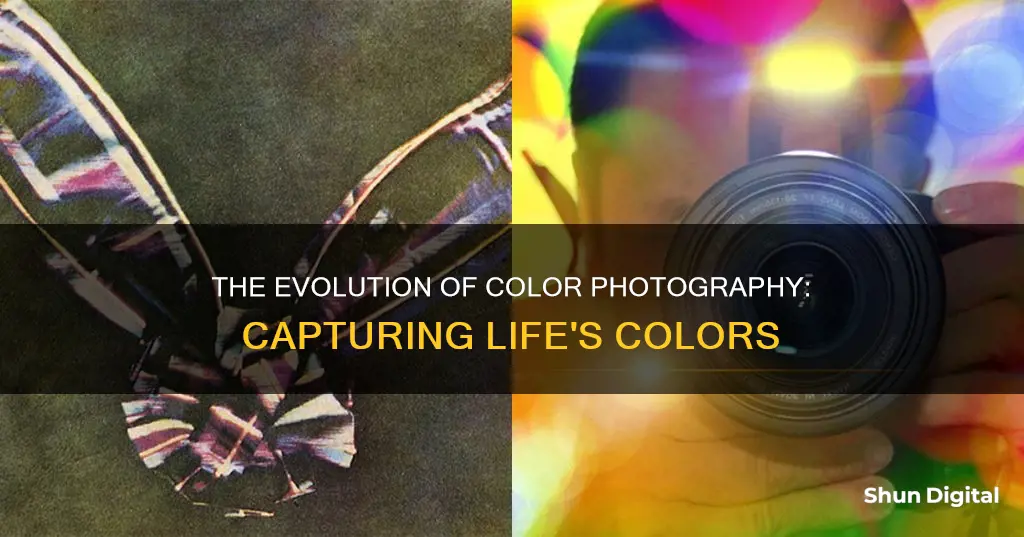
The first colour photograph was unveiled by Scottish physicist James Clerk Maxwell in 1861. However, the first colour camera was not invented until much later.
The first colour photograph was the result of Maxwell's three-colour method, which is the first known way to reproduce colours in a photograph. The process involved taking three separate black-and-white photographs through red, green, and blue filters, and then projecting them onto a screen using three different projectors, each with their own colour filter. This created the illusion of a full-colour image.
While this process did work, it was very time-consuming and required a lot of equipment. It wasn't until the 20th century that colour photography became more widely used, with the invention of the first colour film.
| Characteristics | Values |
|---|---|
| First colour photograph | Taken in 1861 by Scottish physicist James Clerk Maxwell |
| First colour photograph process | The three-colour method, also first suggested by Maxwell in 1855 |
| First colour photograph without colourisation | Created by Gabriel Lippmann in 1886, winning him the Nobel Prize in Physics in 1908 |
| First commercial colour film | Kodachrome, introduced by Kodak in 1935 |
What You'll Learn

The first colour photograph
The photograph was of a tartan ribbon, which Sutton captured through red, green, and blue filters, and then recombined the images into one colour composite. The resulting slides were then projected through three similarly filtered lenses, resulting in a colour photograph.
The process was based on the three-colour method, which was first suggested in an 1855 paper on colour vision by Maxwell. The theory is based on the Young-Helmholtz theory that the normal human eye sees colour because its inner surface is covered with millions of intermingled cone cells of three types. Each type is most sensitive to the end of the spectrum we call red, green, or blue.
Camera LED: Why Does It Blink Without a Battery?
You may want to see also

The three-colour method
In his studies of colour vision, Maxwell showed that any visible hue or grey tone could be created by mixing only three pure colours of light – red, green, and blue – in proportions that would stimulate the three types of cone cells to the same degree under particular lighting conditions.
The first colour photograph, made according to Maxwell's prescription, was taken by Thomas Sutton in 1861. The photograph was a set of three monochrome "colour separations" of a bow made of ribbon with stripes of various colours. The photograph was used to illustrate a lecture on colour by Maxwell, where it was shown in colour by the triple projection method.
Simplisafe Cameras: Battery-Powered or Direct Plug-in?
You may want to see also

The Autochrome process
How Autochromes Work
Autochrome plates are covered in microscopic red, green and blue-coloured potato starch grains (about four million per square inch). When the photograph is taken, light passes through these colour filters to the photographic emulsion. The plate is then processed to produce a positive transparency. Light, passing through the coloured starch grains, combines to recreate a full-colour image of the original subject.
How Autochromes Were Made
The manufacture of Autochrome plates was undertaken at the Lumière factory in Lyon, and was a complex industrial process. First, transparent starch grains were passed through a series of sieves to isolate grains between ten and fifteen microns (thousandths of a millimetre) in diameter. These microscopic starch grains were separated into batches, dyed red, green and violet, mixed together and then spread over a glass plate coated with a sticky varnish.
Next, carbon black (charcoal powder) was spread over the plate to fill in any gaps between the coloured starch grains. A roller submitted the plate to a pressure of five tons per square centimetre to spread the grains and flatten them out. Finally, the plate was coated with a panchromatic photographic emulsion.
How Autochromes Were Taken
Photographers could use their existing cameras, but they had to remember to place the Autochrome plate in the camera with the plain glass side nearest the lens so that light passed through the filter screen before reaching the sensitive emulsion. Exposures were made through a yellow filter which corrected the excessive blue sensitivity of the emulsion for a more accurate colour rendering. This, combined with the light-filtering effect of the dyed starch grains, meant that exposure times were very long, about thirty times that of monochrome plates.
How Autochromes Were Viewed
For private viewing, Autochromes could simply be held up to the light. However, for ease and comfort, they were usually viewed using special stands called diascopes, which incorporated a mirror. These gave a brighter image and allowed several people to look at the plate at the same time. For public exhibition, Autochromes were also projected using a magic lantern.
Recycling Camera Batteries: Safe Disposal and Environmentally Friendly Options
You may want to see also

The Kodachrome film
Kodachrome was the first mass-marketed colour film, introduced by Eastman Kodak in 1935. It was one of the first successful colour materials and was used for both cinematography and still photography. Kodachrome was widely used for professional colour photography, especially for images intended for publication in print media.
Kodachrome was the brainchild of Leopold Godowsky Jr. and Leopold Mannes, two musicians turned scientists who worked at Kodak's research facility in Rochester, New York. The two Leopolds were disappointed by the poor quality of a "colour" movie they saw in 1916 and spent years perfecting their technique. The Kodachrome process involves coating three emulsions, each sensitive to a primary colour, onto a single film base.
Kodachrome was initially sold with the cost of processing included in the price. Customers had to mail the film to Kodak, which would then send the developed film back as part of the purchase price. In 1954, the U.S. Department of Justice found that this practice violated antitrust laws by being uncompetitive. Kodak then entered into a consent decree, requiring the company to offer Kodachrome film for sale without the development fee, as well as license Kodachrome development patents to independent photography stores.
Kodachrome's popularity peaked in the 1960s and 1970s, when Americans' urge to catalogue every single holiday, family vacation and birthday celebration hit its stride. Kodachrome II, a faster, more versatile version of the film, came out in 1961, making it even more appealing to the point-and-shoot generation. Kodachrome's dominance was eventually eroded by the growth and popularity of alternative photographic materials, and later by the widespread transition to digital photography. In 2009, Kodak announced it would no longer manufacture Kodachrome film, citing declining demand.
Mastering Camera Modes: When to Use Each One
You may want to see also

The future of colour photography
The history of colour photography is a long and fascinating one, dating back to the mid-19th century when photographers and scientists first attempted to capture colour on film. The first colour photograph is generally attributed to Scottish physicist James Clerk Maxwell, who, in 1861, produced a durable colour image using three monochrome "colour separations" taken through red, green, and blue filters and projected them together to create a full-colour image. Despite this breakthrough, colour photography remained a niche pursuit for several decades, with long exposure times and complex processes that often yielded inaccurate results.
It wasn't until the early 20th century that colour photography began to find more mainstream success. The Lumière brothers' Autochrome, introduced in 1907, was the first commercially successful colour process, using dyed potato starch grains to create a colour image on a glass plate. This was followed by the first synthetic dye-based colour film in 1935, invented by French brothers Francois and Louis Methylene, which offered more accurate colours at a lower cost.
In the 1950s, colour photography truly entered the mainstream with the introduction of Kodachrome by Kodak, an easy-to-use colour slide film that produced high-quality results. Since then, colour photography has only grown in popularity, with digital cameras and smartphones now putting powerful photography tools into the hands of anyone.
Today, colour photography is an integral part of our lives, allowing us to capture and share our world in vibrant detail. The future of colour photography holds even more promise, with ongoing advancements in camera technology and image processing ensuring that we will continue to find new and exciting ways to express ourselves and document our lives in colour.
Charging Pentax Cameras: A Quick Guide to Powering Your Device
You may want to see also
Frequently asked questions
The first colour photograph was taken in 1861 by Scottish physicist James Clerk Maxwell.
Maxwell's method involved taking three separate black and white photographs through red, green, and blue filters. These images were then projected onto a screen using three different projectors, each with their own colour filter.
Colour photography became more widely used in the early 20th century, as different colour film processes were developed.
Colour photography became truly mainstream in the 1950s with the introduction of Kodak's Kodachrome colour slide film.







